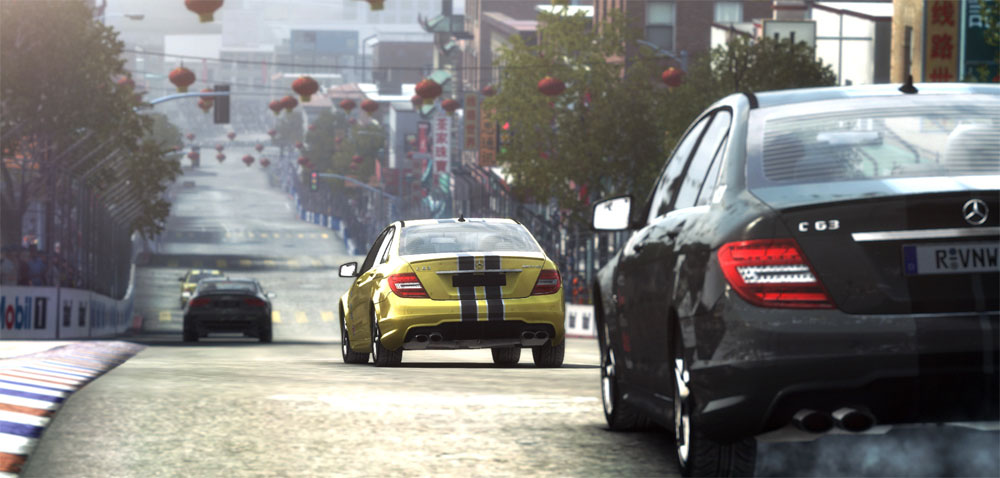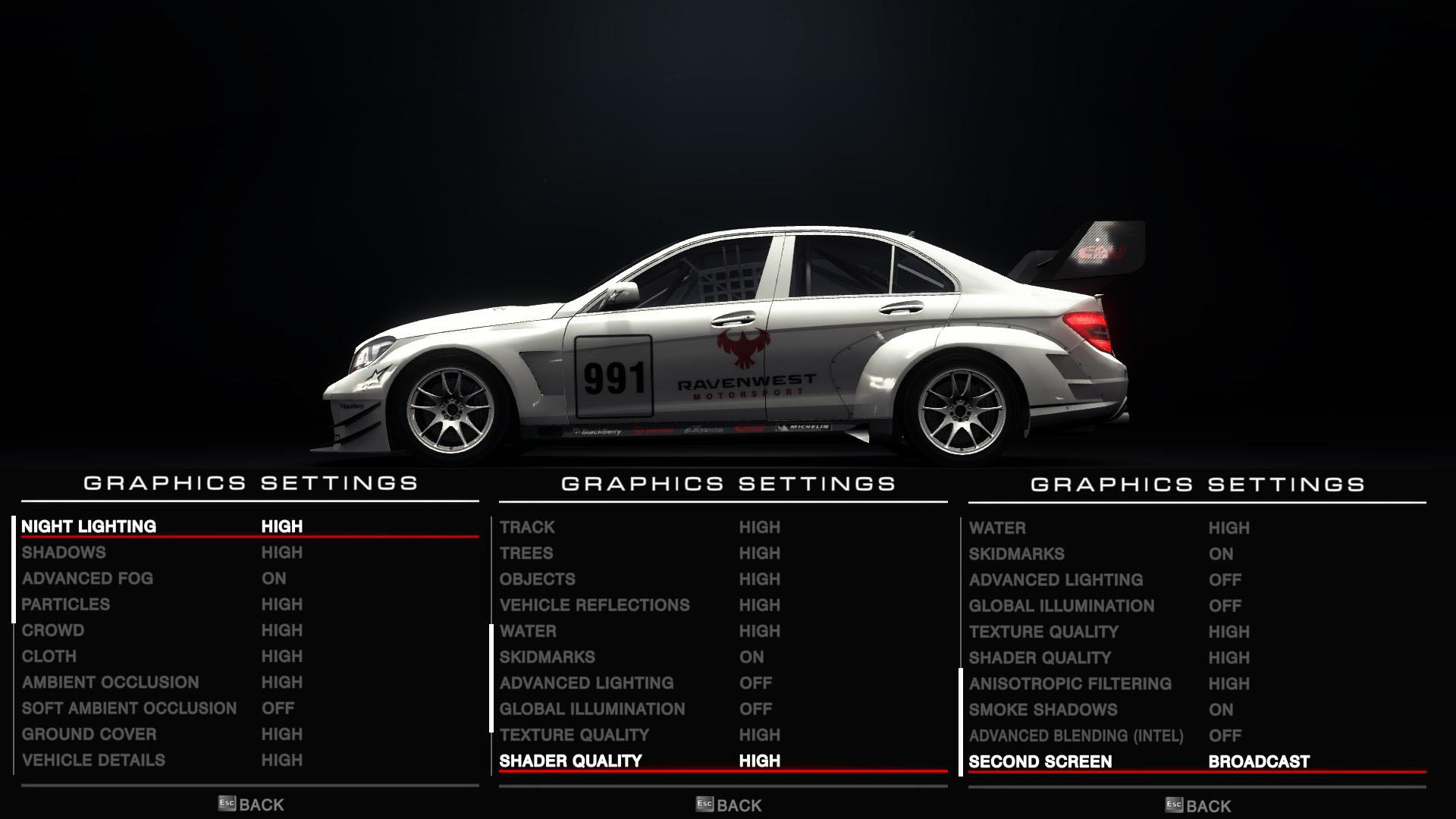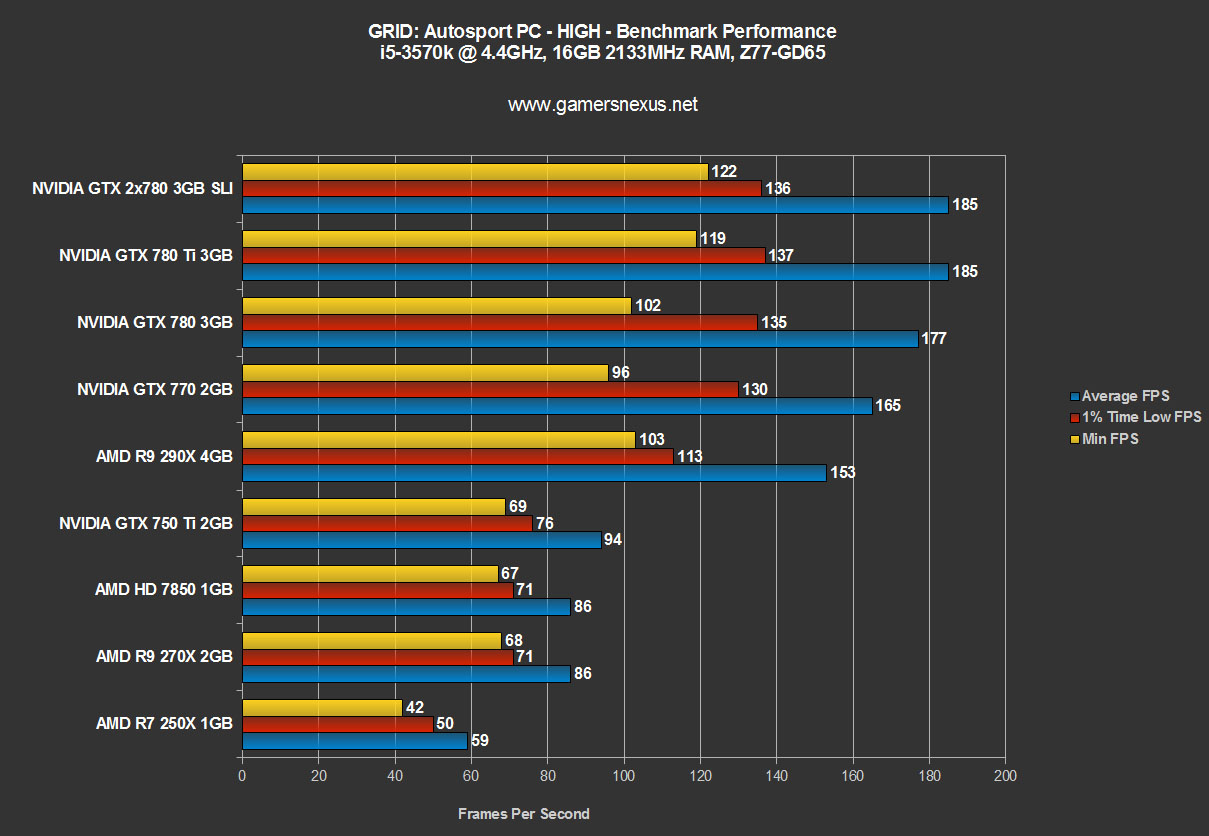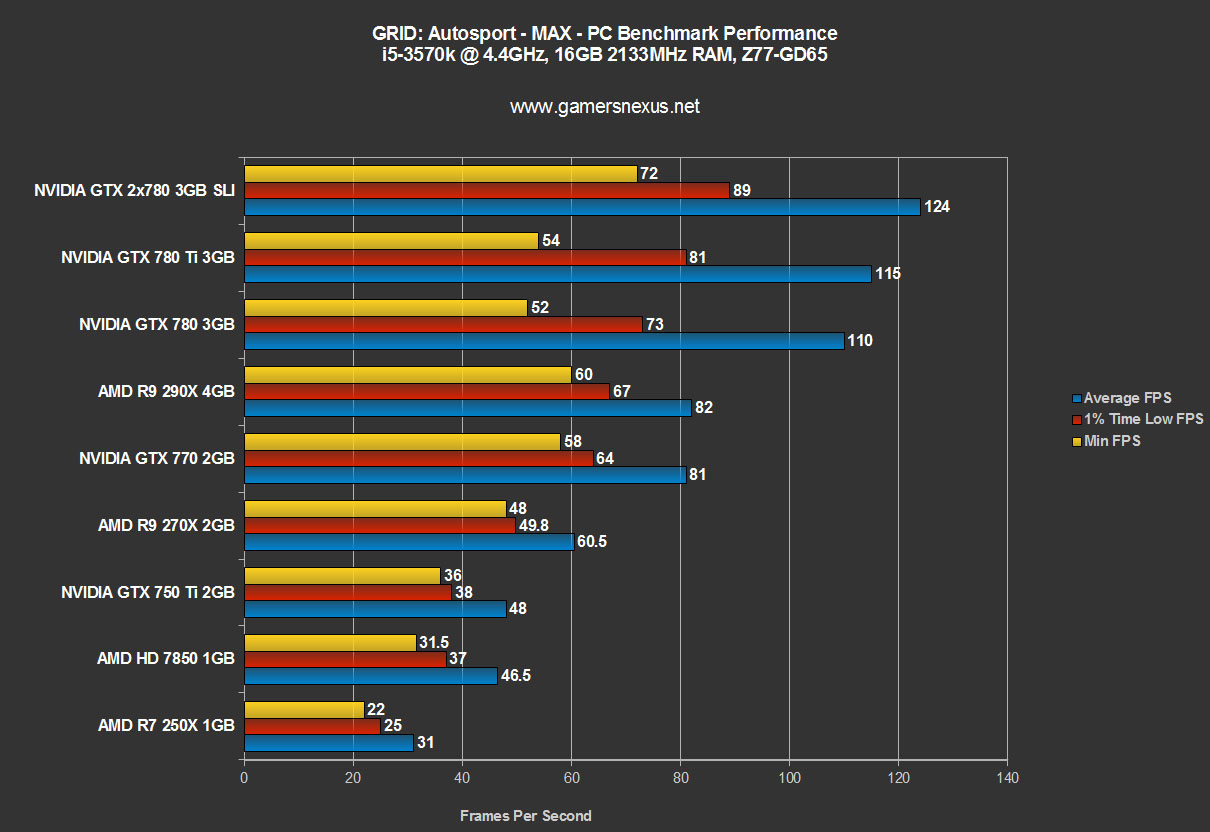GRID: Autosport PC GPU Benchmark - GTX 750 Ti, R7 250X, R9 270X, GTX 770, More
Posted on July 17, 2014
Cars have always been a beacon for visual FX presentations. This is evidenced by nVidia's obsession with real-time ray-tracing in every demonstration the company has ever fronted; and AMD isn't much better off -- their multi-GPU solutions almost always have some vehicle showcase. Cars are somewhat easy to grasp as a visual marvel for just about any onlooker, especially investors and non-gamers, so it makes sense.
Games like Project Cars and GRID have brought some of that technology to the gaming world. GRID: Autosport is the newest game in a now-three-title series by Codemasters. Following the footsteps of GRID 2, Autosport has partnered with Intel for additional graphics tech (like self-shadowing smoke) when coupled with specific architectures. Haswell or better is a requirement for these graphics technologies. The game isn't quite on Project Cars' level of vehicle fidelity, but GRID: Autosport still has beautiful lighting, shading, and environmental effects to bring
Speaking of GPU testing, that's why we're here today. This GRID: Autosport video card benchmark looks at the framerate (FPS) of GRID on various GPUs, including the GTX 750 Ti, R7 250X, 7850, 270X, GTX 770, 780, and even SLI setups.
GRID: Autosport Video Benchmark - MAX Graphics Settings
GRID: Autosport Graphics Settings Explained
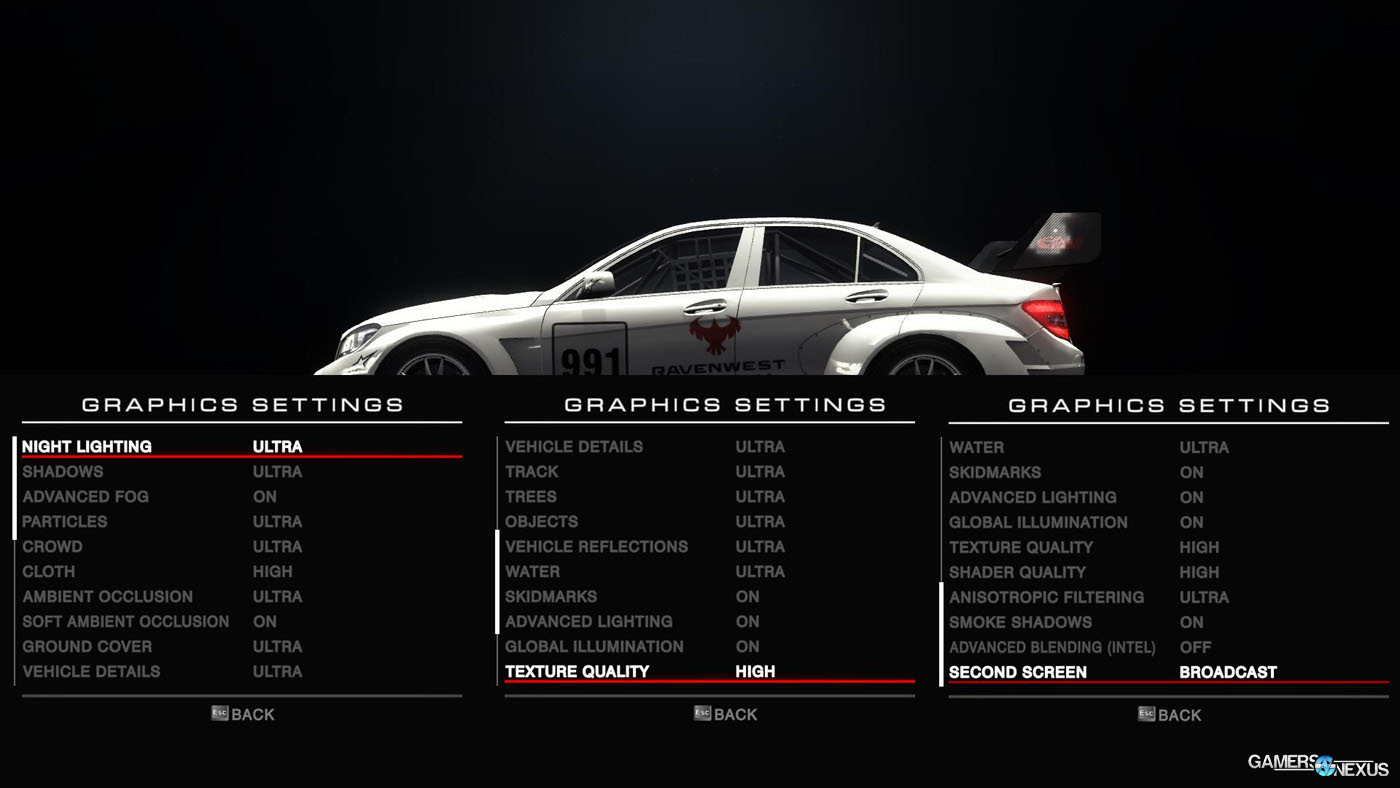 Not pictured: 4xMSAA also used in testing.
Not pictured: 4xMSAA also used in testing.
Unlike our benchmarks of Watch_Dogs and Titanfall, GRID's graphics settings are exceedingly plain-English and straight-forward. There's not much to demystify here. The advanced graphics settings give us control over day/night lighting quality (ranging from "low" to "ultra"), shadows, fog, particle FX, and more. We're still in the process of determining which of these have the largest impact on the CPU versus the GPU, but that's a guide that'll be on the YouTube channel shortly.
There are only a few settings that may be unfamiliar.
Soft Ambient Occlusion (often SSAO) is potentially one of them. Ambient Occlusion (AO) is normally a software-side approach to light exposure along the surface of various materials. In GRID, this primarily effects the shading around the edges of a vehicle, but can also be seen in environmental and atmospheric FX.
Vehicle Reflections is pretty self-explanatory, but is worthy of additional note given its impact on FPS output. This setting controls how accurate and intense the reflectivity of vehicle surfaces are within the game world. Windows and side panels will produce more convincing and accurate reflections (light, environment, other vehicles) with higher settings.
Enabling Global Illumination has a relatively heavy impact on framerate in GRID: Autosport, but produces brilliant lighting effects on the tracks. Global Illumination is a fairly universal term within the world of computer graphics. Enabling Global Illumination means that the game will now spatially account for light sources -- the sun, street lights, track lights -- and then further amplify this by tracking diffracted or reflected rays as they collide with other objects. Say a ray of light (like a 'god ray') is traced from a light source (the sun) to your car's shiny, metallic surface. Enabling Global Illumination will continue tracing this ray along its path (within parameters defined by the developers) until it collides with the next object. This means the game can produce incredibly complex scenes where a single ray of light is traced across multiple surfaces.
Beyond that, the rest is pretty standard terminology. Let us know if you've got questions, though.
Test Methodology
We tested GRID: Autosport on nine video card configurations with a constant host platform. The GRID: Autosport FPS benchmark was conducted using two different settings within the game: the preset "high" setting and a custom "max" setting. Our tuned "max" setting started from the baseline "ultra" preset, but then added Global Illumination, SSAO, and advanced lighting.
All tests were conducted three times for parity, each using the built-in GRID: Autosport graphics benchmark tool. The tool can be accessed through the graphics options and looped until cancelation, at which point an XML file is compiled with results. We used FRAPS' benchmark utility for real-time measurement of the framerate, then used FRAFS to analyze the 1% high, 1% low, min, max, and average FPS; FRAFS was further used to dissect the frametime performance of the GPUs, though that will not be covered here (as it is more related to drivers and GPUs than to GRID).
NVidia 340.43 beta drivers were used for all tests conducted on nVidia's GPUs. The 340.43 beta introduced performance improvements specifically for GRID. AMD 14.7 drivers were used for the AMD cards, which contain no notes of GRID-specific improvements.
| GN Test Bench 2013 | Name | Courtesy Of | Cost |
| Video Card | (This is what we're testing). XFX Ghost 7850 | GamersNexus, AMD, NVIDIA, CyberPower, ZOTAC. | Ranges |
| CPU | Intel i5-3570k CPU Intel i7-4770K CPU (alternative bench). | GamersNexus CyberPower | ~$220 |
| Memory | 16GB Kingston HyperX Genesis 10th Anniv. @ 2400MHz | Kingston Tech. | ~$117 |
| Motherboard | MSI Z77A-GD65 OC Board | GamersNexus | ~$160 |
| Power Supply | NZXT HALE90 V2 | NZXT | Pending |
| SSD | Kingston 240GB HyperX 3K SSD | Kingston Tech. | ~$205 |
| Optical Drive | ASUS Optical Drive | GamersNexus | ~$20 |
| Case | Phantom 820 | NZXT | ~$130 |
| CPU Cooler | Thermaltake Frio Advanced | Thermaltake | ~$65 |
The system was kept in a constant thermal environment (21C - 22C at all times) while under test. 4x4GB memory modules were kept overclocked at 2133MHz. All case fans were set to 100% speed and automated fan control settings were disabled for purposes of test consistency and thermal stability.
A 120Hz display was connected for purposes of ensuring frame throttles were a non-issue. The native resolution of the display is 1920x1080. V-Sync was completely disabled for this test.
We ran the following settings for all discrete devices under test (DUT):
A few additional tests were performed as one-offs to test various graphics settings for impact.
The video cards tested include:
- AMD Radeon R9 290X 4GB (provided by CyberPower).
- AMD Radeon R9 270X 2GB (we're using reference; provided by AMD).
- AMD Radeon HD 7850 1GB (bought by GamersNexus).
- AMD Radeon R7 250X 1GB (equivalent to HD 7770; provided by AMD).
- NVidia GTX 780 Ti 3GB (provided by nVidia).
- NVidia GTX 780 3GB x 2 (provided by ZOTAC).
- NVidia GTX 770 2GB (we're using reference; provided by nVidia).
- NVidia GTX 750 Ti Superclocked 2GB (provided by nVidia).
GRID: Autosport PC Benchmark - High - 750 Ti, 250X, 770, 780 Ti, 290X, etc.
GRID appears to be an incredibly optimized game given its overall high-fidelity graphics. The racing game was reasonably playable on AMD's low-end R7 250X 1GB video card ($100), averaging out at nearly 60FPS with all "high" settings. Dropping a few settings to "medium" would easily put this at a constant 60+ FPS with higher 1% low ratings.
The 270X oddly tied with the 7850 (even after a retest) in GRID, and the 290X performed disproportionately poorly (also retested) to nVidia's neighboring offerings. It still pushed 153 FPS -- more than anyone could ask for -- but the hierarchical card ranking in GRID is not reflective of device cost. The most likely explanation of this is that GRID is optimized for nVidia hardware, a statement backed-up by the stellar performance of the 750 Ti 2GB ($120) when compared to the statistically-superior 270X.
GRID: Autosport PC Benchmark - Ultra - 750 Ti, 250X, 770, 780 Ti, 290X, etc.
The video card rankings equalize a little bit in the ultra/max test, likely because raw power produces greater gains with the added load (compared to lower-end cards, which will start struggling).
A solid 60FPS average is produced by the R9 270X 2GB card ($170) on ultra/max settings, with the 750 Ti dropping off in performance noticeably. The GTX 770 2GB card ($330) pushed 80 FPS average, indicating that a more reasonably-priced GTX 760 ($230) should fall somewhere between the 770 and 270X in performance.
A Note on SLI
We always try to specifically mention SLI and CrossFire performance when writing these game benchmarks. Watch_Dogs and Titanfall both exhibited severe, unplayable microstuttering and lag issues when using dual-GPU technologies, but GRID appears to support SLI fully and runs perfectly smoothly on the two ZOTAC GTX 780 cards. We were unfortunately unable to test CrossFire performance with GRID at this time due to card availability on the bench. This will be resolved going forward.
Conclusion - What's the best video card for GRID: Autosport?
First, note that all tests were conducted with a single-monitor, 1080p, 120Hz solution. GRID is one of the first games to natively offer multimonitor functionality beyond a higher resolution (added features on the secondary monitor), and enabling these features will impact performance to some degree. We did not test this performance hit, so keep that in mind if you're going for dual monitors.
GRID is one of the best-optimized games we've benchmarked in recent history. SLI is smooth and exhibits no jarring microstuttering, performance scaling is mostly predictable within each company's solutions (but odd cross-company), and the game is largely playable on any gaming-grade GPU. If you're already on a 7850 or 650 Ti Boost from the previous generation, I'd say that there's no reason to upgrade for GRID -- both cards will play comfortably above the 60FPS baseline that most gamers demand.
For those buying a new GPU, the budget arena is easily handled by the 250X or 750 Ti for GRID. The GTX 750 Ti is superior in value, but if that extra $20 puts a hole in your pocket, the 250X is honestly not a bad solution. You'd probably be running a mix of high/medium for best FPS. I would personally advise the 750 Ti or better, though.
In order to play GRID comfortably at maximum settings with a single 1080p display, our recommendation would point you toward either the 270X or GTX 760, depending on if either company's software suite adds value for you. The 270X is one of the most affordable cards (in terms of performance) presently on the market, and its performance in GRID is admirable on max settings.
Anything more than that is unnecessary for a single-monitor, 1080p configuration.
Let us know if you have questions about system building or graphics tweaks for GRID: Autosport!
- Steve "Lelldorianx" Burke.
